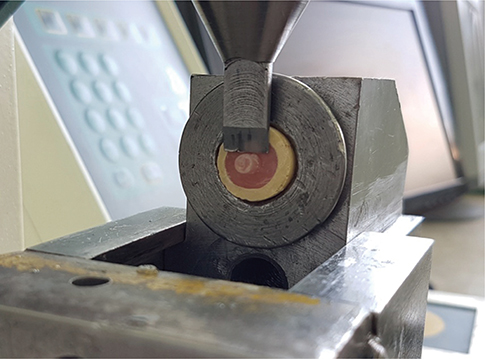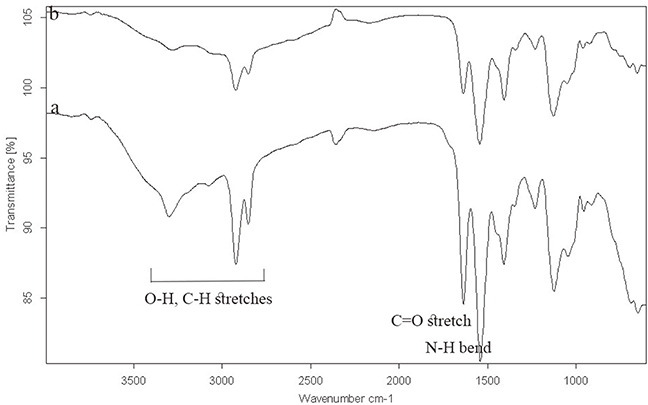J Adv Prosthodont.
2016 Dec;8(6):504-510. 10.4047/jap.2016.8.6.504.
Effect of surface treatment methods on the shear bond strength of auto-polymerized resin to thermoplastic denture base polymer
- Affiliations
-
- 1Department of Prosthodontics, Faculty of Dentistry, Tabriz University of Medical Sciences, Tabriz, Iran. Hafezeqoran@gmail.com
- KMID: 2382597
- DOI: http://doi.org/10.4047/jap.2016.8.6.504
Abstract
- PURPOSE
Polyamide polymers do not provide sufficient bond strength to auto-polymerized resins for repairing fractured denture or replacing dislodged denture teeth. Limited treatment methods have been developed to improve the bond strength between auto-polymerized reline resins and polyamide denture base materials. The objective of the present study was to evaluate the effect of surface modification by acetic acid on surface characteristics and bond strength of reline resin to polyamide denture base.
MATERIALS AND METHODS
84 polyamide specimens were divided into three surface treatment groups (n=28): control (N), silica-coated (S), and acid-treated (A). Two different auto-polymerized reline resins GC and Triplex resins were bonded to the samples (subgroups T and G, respectively, n=14). The specimens were subjected to shear bond strength test after they were stored in distilled water for 1 week and thermo-cycled for 5000 cycles. Data were analyzed with independent t-test, two-way analysis of variance (ANOVA), and Tukey's post hoc multiple comparison test (α=.05).
RESULTS
The bond strength values of A and S were significantly higher than those of N (P<.001 for both). However, statistically significant difference was not observed between group A and group S. According to the independent Student's t-test, the shear bond strength values of AT were significantly higher than those of AG (P<.001).
CONCLUSION
The surface treatment of polyamide denture base materials with acetic acid may be an efficient and cost-effective method for increasing the shear bond strength to auto-polymerized reline resin.
MeSH Terms
Figure
Cited by 1 articles
-
Nonthermal plasma on the shear bond strength of relining resin to thermoplastic denture base resin
Manaloto-Ceballos Liezl, Wilmart Labriaga, So-Yeon Song, Jin-Hong Park, Jeong-Yol Lee, Sang-Wan Shin
J Korean Acad Prosthodont. 2018;56(3):199-205. doi: 10.4047/jkap.2018.56.3.199.
Reference
-
1. Meng GK, Chung KH, Fletcher-Stark ML, Zhang H. Effect of surface treatments and cyclic loading on the bond strength of acrylic resin denture teeth with autopolymerized repair acrylic resin. J Prosthet Dent. 2010; 103:245–252.2. Ucar Y, Akova T, Aysan I. Mechanical properties of polyamide versus different PMMA denture base materials. J Prosthodont. 2012; 21:173–176.3. Fueki K, Ohkubo C, Yatabe M, Arakawa I, Arita M, Ino S, Kanamori T, Kawai Y, Kawara M, Komiyama O, Suzuki T, Nagata K, Hosoki M, Masumi S, Yamauchi M, Aita H, Ono T, Kondo H, Tamaki K, Matsuka Y, Tsukasaki H, Fujisawa M, Baba K, Koyano K, Yatani H. Clinical application of removable partial dentures using thermoplastic resin-part I: definition and indication of non-metal clasp dentures. J Prosthodont Res. 2014; 58:3–10.4. Kohli S, Bhatia S. Flexural properties of polyamide versus injection-molded polymethylmethacrylate denture base materials. Eur J Prosthodont. 2013; 1:63–67.5. Soygun K, Bolayir G, Boztug A. Mechanical and thermal properties of polyamide versus reinforced PMMA denture base materials. J Adv Prosthodont. 2013; 5:153–160.6. Alkurt M, Yeşil Duymuş Z, Gundogdu M. Effect of repair resin type and surface treatment on the repair strength of heat-polymerized denture base resin. J Prosthet Dent. 2014; 111:71–78.7. Fueki K, Ohkubo C, Yatabe M, Arakawa I, Arita M, Ino S, Kanamori T, Kawai Y, Kawara M, Komiyama O, Suzuki T, Nagata K, Hosoki M, Masumi S, Yamauchi M, Aita H, Ono T, Kondo H, Tamaki K, Matsuka Y, Tsukasaki H, Fujisawa M, Baba K, Koyano K, Yatani H. Clinical application of removable partial dentures using thermoplastic resin. Part II: Material properties and clinical features of non-metal clasp dentures. J Prosthodont Res. 2014; 58:71–84.8. Kim JH, Choe HC, Son MK. Evaluation of adhesion of reline resins to the thermoplastic denture base resin for non-metal clasp denture. Dent Mater J. 2014; 33:32–38.9. Katsumata Y, Hojo S, Hamano N, Watanabe T, Yamaguchi H, Okada S, Teranaka T, Ino S. Bonding strength of autopolymerizing resin to nylon denture base polymer. Dent Mater J. 2009; 28:409–418.10. Sarac YS, Sarac D, Kulunk T, Kulunk S. The effect of chemical surface treatments of different denture base resins on the shear bond strength of denture repair. J Prosthet Dent. 2005; 94:259–266.11. Takahashi Y, Chai J. Assessment of shear bond strength between three denture reline materials and a denture base acrylic resin. Int J Prosthodont. 2001; 14:531–535.12. Mutluay MM, Ruyter IE. Evaluation of adhesion of chairside hard relining materials to denture base polymers. J Prosthet Dent. 2005; 94:445–452.13. Azevedo A, Machado AL, Giampaolo ET, Pavarina AC, Vergani CE. The effect of water immersion on the shear bond strength between chairside reline and denture base acrylic resins. J Prosthodont. 2007; 16:255–262.14. Takabayashi Y. Characteristics of denture thermoplastic resins for non-metal clasp dentures. Dent Mater J. 2010; 29:353–361.15. Brown HR. Adhesion of polymers. MRS Bull. 1996; 21:24–27.16. Meloto CB, Silva-Concílio LR, Rodrigues-Garciai RC, Canales GT, Rizzatti-Barbosa CM. Effect of surface treatments on the bond strength of different resin teeth to complete denture base material. Acta Odontol Latinoam. 2013; 26:37–42.17. Heikkinen TT, Lassila LV, Matinlinna JP, Vallittu PK. Effect of operating air pressure on tribochemical silica-coating. Acta Odontol Scand. 2007; 65:241–248.18. Kern M, Thompson VP. Sandblasting and silica coating of a glass-infiltrated alumina ceramic: volume loss, morphology, and changes in the surface composition. J Prosthet Dent. 1994; 71:453–461.19. Nirmala R, Panth HR, Yi C, Nam KT, Park SJ, Kim HY, Navamathavan R. Effect of solvents on high aspect ratio polyamide-6 nanofibers via electrospinning. Macromol Res. 2010; 18:759–765.20. Jacques B, Werth M, Merdas I, Thominette F, Verdu J. Hydrolytic ageing of polyamide 11. 1. Hydrolysis kinetics in water. Polymer. 2002; 43:6439–6447.21. Richaud E, Derue I, Gilormini P, Verdu J, Vaulot C, Coquillat M, Desgardin N, Vandenbrouke A. Plasticizer effect on network structure and hydrolytic degradation. Eur Polym J. 2015; 69:232–246.22. Serpe G, Chaupart N, Verdu J. Ageing of polyamide 11 in acid solutions. Polymer. 1997; 38:1911–1917.23. Murthy NS. Hydrogen bonding, mobility, and structural transitions in aliphatic polyamides. J Polym Sci Part B: Polym Phys. 2006; 44:1763–1782.24. Hocker S, Rhudy AK, Ginsburg G, Kranbuehl DE. Polyamide hydrolysis accelerated by small weak organic acids. Polym. 2014; 55:5057–5064.25. El-Mazry C, Correc O, Colin X. A new kinetic model for predicting polyamide 6-6 hydrolysis and its mechanical embrittlement. Polym Degrad Stab. 2012; 97:1049–1059.26. Bernstein R, Derzon DK, Gillen KT. Nylon 6.6 accelerated aging studies: thermal-oxidative degradation and its interaction with hydrolysis. Polym Degrad Stab. 2005; 88:480–488.27. Meyer A, Jones N, Lin Y, Kranbuehl D. Characterizing and modeling the hydrolysis of polyamide-11 in a pH 7 water environment. Macromolecules. 2002; 35:2784–2798.28. Chaupart N, Serpe G, Verdu J. Molecular weight distribution and mass changes during polyamide hydrolysis. Polymer. 1998; 39:1375–1380.29. Sirisha K, Rambabu T, Ravishankar Y, Ravikumar P. Validity of bond strength tests: A critical review-Part II. J Conserv Dent. 2014; 17:420–426.30. Lung CY, Matinlinna JP. Aspects of silane coupling agents and surface conditioning in dentistry: an overview. Dent Mater. 2012; 28:467–477.31. Sarmento HR, Campos F, Sousa RS, Machado JP, Souza RO, Bottino MA, Ozcan M. Influence of air-particle deposition protocols on the surface topography and adhesion of resin cement to zirconia. Acta Odontol Scand. 2014; 72:346–353.32. Sakai T, Sembokuya H, Kubouchi M, Tsuda K. The reciprocal influence between ion transport and degradation of PA66 in acid solution. Polym Degrad Stab. 2006; 91:2595–2604.33. Ward JH, Furman K, Peppas NA. Effect of monomer type and dangling end size on polymer network synthesis. J Appl Polym Sci. 2003; 89:3506–3519.34. Vallittu PK. Interpenetrating polymer networks (IPNs) in dental polymers and composites. J Adhes Sci Technol. 2009; 23:961–972.35. Liu S, Zhao N, Rudenja S. Surface interpenetrating networks of poly(ethylene terephthalate) and polyamides for effective biocidal properties. Macromol Chem Phys. 2010; 211:286–296.36. Wolff D, Geiger S, Ding P, Staehle HJ, Frese C. Analysis of the interdiffusion of resin monomers into pre-polymerized fiber-reinforced composites. Dent Mater. 2012; 28:541–547.
- Full Text Links
- Actions
-
Cited
- CITED
-
- Close
- Share
- Similar articles
-
- Nonthermal plasma on the shear bond strength of relining resin to thermoplastic denture base resin
- Comparison of shear bond strengths of different types of denture teeth to different denture base resins
- Tensile bond strength between auto-polymerized acrylic resin and acrylic denture teeth treated with MF-MA solution
- The Effects Of Thermocycling On The Bond Strength Between Cobalt-Chromium Alloy And Denture Base Resin
- Comparison of shear bond strength between hard relining material and 3D-printing denture base resin containing silica micro-gel




